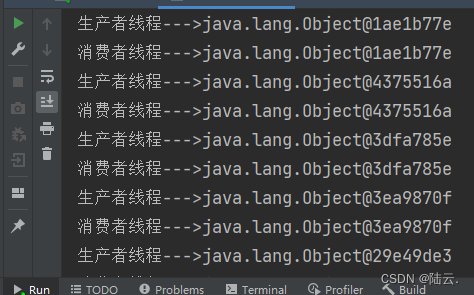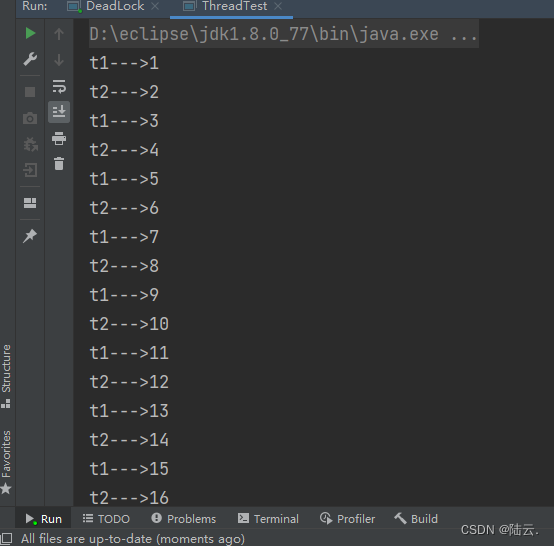1、什么是“生产者和消费者模式”?
- 生产线程负责生产,消费线程负责消费
- 生产线程和消费线程要达到均衡
- 这是一种特殊的业务需求,在这种特殊的情况下需要使用wait方法和notify方法
2、wait和notify方法不是线程对象的方法,是普通java对象都有的方法
3、wait和notify方法建立在线程同步的基础之上。因为多线程要同时操作一个仓库。有线程安全问题
4、wait方法作用:o.wait()让正在o对象上活动的线程t进入等待状态,并且释放掉t线程之前占有的o对象的锁
5、notify方法作用:o.notify()让正在o对象上等待的线程唤醒,只是通知,不会释放o对象上之前占有的锁
6、模拟需求:
- 仓库我们采用List集合
List集合中假设只能存储一个元素
1个元素就表示仓库满l
如果List集合中元素个数是0,就表示仓库空了
保证List集合中永远都是最多存储一个元素了
必须做到,生产一个,消费一个


示例代码01:
public class ThreadTest16 {
public static void main(String[] args) {
//创建一个仓库对象,共享的
List list = new ArrayList();
//创建对象
//创建生产者对象
Thread t1 = new Producter(list);
//创建消费者对象
Thread t2 = new Consumer(list);
t1.setName("生产者线程");
t2.setName("消费者线程");
//启动线程
t1.start();
t2.start();
}
}
//生产者线程
class Producter extends Thread{
private List list;
public Producter(List list){
this.list = list;
}
public void run(){
while(true) {
synchronized (list) {
if (list.size() > 0) {
try {
list.wait();
} catch (InterruptedException e) {
e.printStackTrace();
}
}
Object obj = new Object();
list.add(obj);
System.out.println(Thread.currentThread().getName() + "--->" + obj);
//线程唤醒
list.notifyAll();
}
}
}
}
//消费者线程
class Consumer extends Thread{
private List list;
public Consumer(List list){
this.list = list;
}
public void run(){
while(true){
synchronized (list) {
if (list.size() == 0) {
try {
list.wait();
} catch (InterruptedException e) {
e.printStackTrace();
}
}
Object obj = list.remove(0);
System.out.println(Thread.currentThread().getName() + "--->" + obj);
list.notifyAll();
}
}
}
}
运行结果:

使用生产者和消费者模式实现,交替输出:
假设只有两个线程,输出以下结果:
- t1—>1
t2—>2
t3—>3
t4—>4
t5—>5
t6—>6
t7—>7
要求:必须交替执行,并且t1线程负责输出奇数,t2线程输出偶数
两个线程共享一个数字,每个线程执行时都要对这个数字进行:++
示例代码02:
public class ThreadTest {
public static void main(String[] args) {
//创建数字类对象
Num num = new Num();
//创建生产者对象
Thread t1 = new Producter(num);
//创建消费者对象
Thread t2 = new Consumer(num);
//修改线程名字
t1.setName("t1");
t2.setName("t2");
//启动线程
t1.start();
t2.start();
}
}
//共享数据
class Num{
int i = 1;
}
//生产者线程
class Producter extends Thread{
private Num num;
public Producter(Num num){
this.num = num;
}
public void run(){
while(true){
synchronized (num) {
if ((num.i % 2) == 0) {
try {
num.wait();
} catch (InterruptedException e) {
e.printStackTrace();
}
}
System.out.println(Thread.currentThread().getName() + "--->" + num.i++);
try {
//延迟1秒输出
Thread.sleep(1000);
} catch (InterruptedException e) {
e.printStackTrace();
}
num.notifyAll();
}
}
}
}
//消费者线程
class Consumer extends Thread{
private Num num;
public Consumer(Num num){
this.num = num;
}
public void run(){
while(true){
synchronized (num) {
if ((num.i % 2) == 1) {
try {
num.wait();
} catch (InterruptedException e) {
e.printStackTrace();
}
}
System.out.println(Thread.currentThread().getName() + "--->" + num.i++);
try {
//延迟一秒输出
Thread.sleep(1000);
} catch (InterruptedException e) {
e.printStackTrace();
}
num.notifyAll();
}
}
}
}
运行结果:























 326
326











 被折叠的 条评论
为什么被折叠?
被折叠的 条评论
为什么被折叠?










